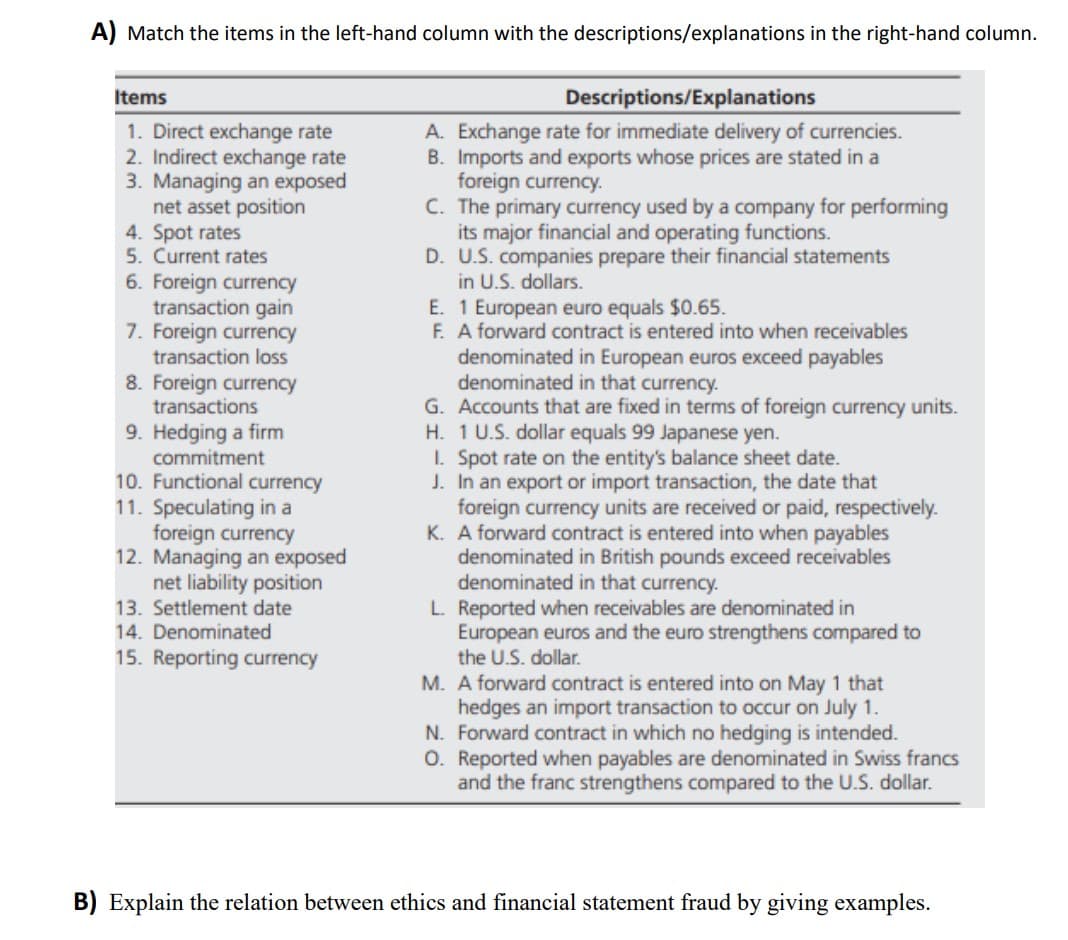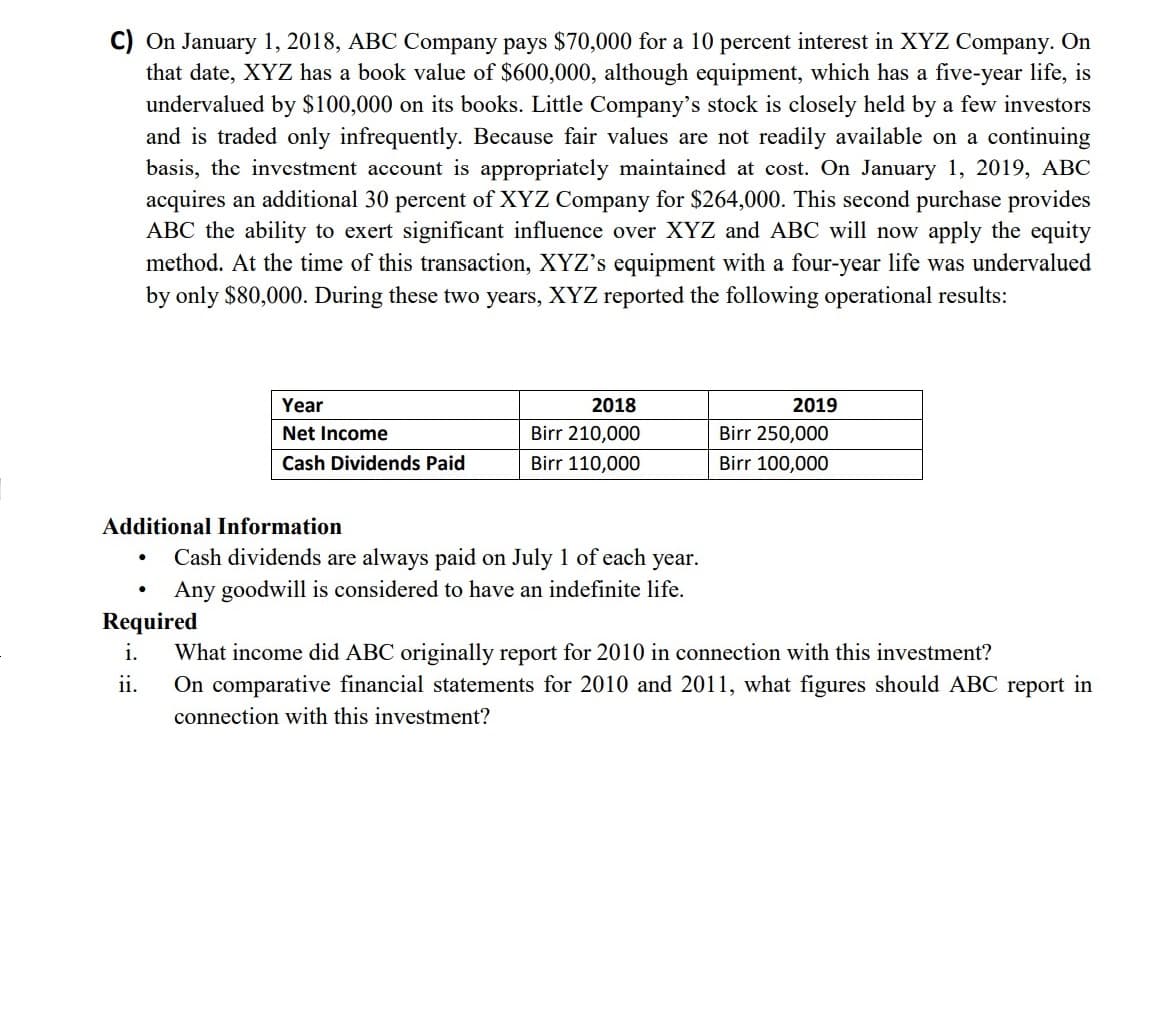A) Match the items in the left-hand column with the descriptions/explanations in the right-hand column. Items Descriptions/Explanations A. Exchange rate for immediate delivery of currencies. B. Imports and exports whose prices are stated in a foreign currency. C. The primary currency used by a company for performing its major financial and operating functions. D. U.S. companies prepare their financial statements in U.S. dollars. E. 1 European euro equals $0.65. F. A forward contract is entered into when receivables denominated in European euros exceed payables denominated in that currency. G. Accounts that are fixed in terms of foreign currency units. H. 1 U.S. dollar equals 99 Japanese yen. I. Spot rate on the entity's balance sheet date. J. In an export or import transaction, the date that foreign currency units are received or paid, respectively. K. A forward contract is entered into when payables denominated in British pounds exceed receivables denominated in that currency. L. Reported when receivables are denominated in European euros and the euro strengthens compared to the U.S. dollar. M. A forward contract is entered into on May 1 that hedges an import transaction to occur on July 1. N. Forward contract in which no hedging is intended. O. Reported when payables are denominated in Swiss francs and the franc strengthens compared to the U.S. dollar. 1. Direct exchange rate 2. Indirect exchange rate 3. Managing an exposed net asset position 4. Spot rates 5. Current rates 6. Foreign currency transaction gain 7. Foreign currency transaction loss 8. Foreign currency transactions 9. Hedging a firm commitment 10. Functional currency 11. Speculating in a foreign currency 12. Managing an exposed net liability position 13. Settlement date 14. Denominated 15. Reporting currency
A) Match the items in the left-hand column with the descriptions/explanations in the right-hand column. Items Descriptions/Explanations A. Exchange rate for immediate delivery of currencies. B. Imports and exports whose prices are stated in a foreign currency. C. The primary currency used by a company for performing its major financial and operating functions. D. U.S. companies prepare their financial statements in U.S. dollars. E. 1 European euro equals $0.65. F. A forward contract is entered into when receivables denominated in European euros exceed payables denominated in that currency. G. Accounts that are fixed in terms of foreign currency units. H. 1 U.S. dollar equals 99 Japanese yen. I. Spot rate on the entity's balance sheet date. J. In an export or import transaction, the date that foreign currency units are received or paid, respectively. K. A forward contract is entered into when payables denominated in British pounds exceed receivables denominated in that currency. L. Reported when receivables are denominated in European euros and the euro strengthens compared to the U.S. dollar. M. A forward contract is entered into on May 1 that hedges an import transaction to occur on July 1. N. Forward contract in which no hedging is intended. O. Reported when payables are denominated in Swiss francs and the franc strengthens compared to the U.S. dollar. 1. Direct exchange rate 2. Indirect exchange rate 3. Managing an exposed net asset position 4. Spot rates 5. Current rates 6. Foreign currency transaction gain 7. Foreign currency transaction loss 8. Foreign currency transactions 9. Hedging a firm commitment 10. Functional currency 11. Speculating in a foreign currency 12. Managing an exposed net liability position 13. Settlement date 14. Denominated 15. Reporting currency
Financial Reporting, Financial Statement Analysis and Valuation
8th Edition
ISBN:9781285190907
Author:James M. Wahlen, Stephen P. Baginski, Mark Bradshaw
Publisher:James M. Wahlen, Stephen P. Baginski, Mark Bradshaw
Chapter8: Investing Activities
Section: Chapter Questions
Problem 14QE
Related questions
Question
THIS IS WHY I CHOOSE BARTLEBY

Transcribed Image Text:A) Match the items in the left-hand column with the descriptions/explanations in the right-hand column.
Items
Descriptions/Explanations
1. Direct exchange rate
2. Indirect exchange rate
3. Managing an exposed
net asset position
4. Spot rates
5. Current rates
6. Foreign currency
transaction gain
7. Foreign currency
transaction loss
8. Foreign currency
transactions
A. Exchange rate for immediate delivery of currencies.
B. Imports and exports whose prices are stated in a
foreign currency.
C. The primary currency used by a company for performing
its major financial and operating functions.
D. U.S. companies prepare their financial statements
in U.S. dollars.
E. 1 European euro equals $0.65.
F. A forward contract is entered into when receivables
denominated in European euros exceed payables
denominated in that currency.
G. Accounts that are fixed in terms of foreign currency units.
H. 1 U.S. dollar equals 99 Japanese yen.
I. Spot rate on the entity's balance sheet date.
J. In an export or import transaction, the date that
foreign currency units are received or paid, respectively.
K. A forward contract is entered into when payables
denominated in British pounds exceed receivables
denominated in that currency.
L. Reported when receivables are denominated in
European euros and the euro strengthens compared to
the U.S. dollar.
9. Hedging a firm
commitment
10. Functional currency
11. Speculating in a
foreign currency
12. Managing an exposed
net liability position
13. Settlement date
14. Denominated
15. Reporting currency
M. A forward contract is entered into on May 1 that
hedges an import transaction to occur on July 1.
N. Forward contract in which no hedging is intended.
O. Reported when payables are denominated in Swiss francs
and the franc strengthens compared to the U.S. dollar.
B) Explain the relation between ethics and financial statement fraud by giving examples.

Transcribed Image Text:C) On January 1, 2018, ABC Company pays $70,000 for a 10 percent interest in XYZ Company. On
that date, XYZ has a book value of $600,000, although equipment, which has a five-year life, is
undervalued by $100,000 on its books. Little Company's stock is closely held by a few investors
and is traded only infrequently. Because fair values are not readily available on a continuing
basis, the investment account is appropriately maintained at cost. On January 1, 2019, ABC
acquires an additional 30 percent of XYZ Company for $264,000. This second purchase provides
ABC the ability to exert significant influence over XYZ and ABC will now apply the equity
method. At the time of this transaction, XYZ's equipment with a four-year life was undervalued
by only $80,000. During these two years, XYZ reported the following operational results:
Year
2018
2019
Net Income
Birr 210,000
Birr 250,000
Cash Dividends Paid
110,000
sirr 100,000
Additional Information
Cash dividends are always paid on July 1 of each year.
Any goodwill is considered to have an indefinite life.
Required
i.
What income did ABC originally report for 2010 in connection with this investment?
ii.
On comparative financial statements for 2010 and 2011, what figures should ABC report in
connection with this investment?
Expert Solution
This question has been solved!
Explore an expertly crafted, step-by-step solution for a thorough understanding of key concepts.
This is a popular solution!
Trending now
This is a popular solution!
Step by step
Solved in 2 steps with 2 images

Knowledge Booster
Learn more about
Need a deep-dive on the concept behind this application? Look no further. Learn more about this topic, finance and related others by exploring similar questions and additional content below.Recommended textbooks for you

Financial Reporting, Financial Statement Analysis…
Finance
ISBN:
9781285190907
Author:
James M. Wahlen, Stephen P. Baginski, Mark Bradshaw
Publisher:
Cengage Learning

Principles of Accounting Volume 1
Accounting
ISBN:
9781947172685
Author:
OpenStax
Publisher:
OpenStax College


Financial Reporting, Financial Statement Analysis…
Finance
ISBN:
9781285190907
Author:
James M. Wahlen, Stephen P. Baginski, Mark Bradshaw
Publisher:
Cengage Learning

Principles of Accounting Volume 1
Accounting
ISBN:
9781947172685
Author:
OpenStax
Publisher:
OpenStax College
